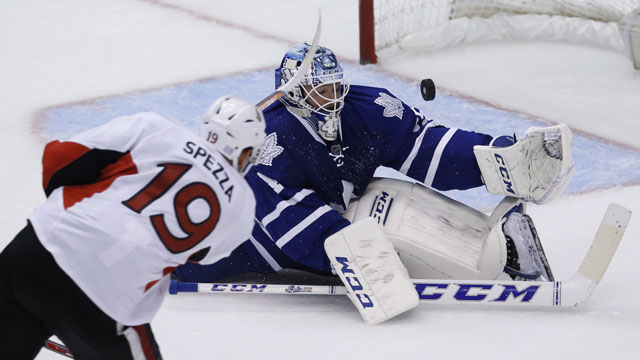NET BENEFITS IN TORONTO
The supposed media and fan-fuelled goaltending controversy in Toronto is actually less of a problem and more of a pleasant predicament for Leafs’ management than anyone seems willing to admit. After starting the millennium with six years of excellent goaltending from Curtis Joseph (1998-2002) and Ed Belfour (2002-2004), the Leafs began a second decade enduring Vesa Toskala as the No. 1, and will have to acknowledge that the jury is still out on James Reimer’s status as a starting goalie in the NHL.
But now, with Jonathan Bernier pushing hard for the full-time gig between the pipes, the worst-case scenario isn’t all that bad: if both goaltenders continue to play at a high level, they trade one of them (likely Reimer) like they did with Felix Potvin in 1999 (to the New York Islanders) and more recently what the Montreal Canadiens did with Jaroslav Halak (to the St. Louis Blues) in 2010. If one falls off (again, likely Reimer), the Leafs have a clear No. 1 and a solid back up with something to prove.
IN DEFENCE OF JUNIOR
I don’t like the idea of burning a players’ years of junior eligibility, especially on defencemen struggling with the big club while they’ve got options left in junior. Memories of Jim Benning, Fred Bomistruck, Bob McGill, Al Iafrate, Luke Richardson, Jeff Ware, Carlo Colaiacovo and most recently Luke Schenn recall players who would have benefited more from remaining in junior.
But I’m beginning to think Morgan Reilly might be an exception. Partly with his solid play so far, but mainly with the lack of depth on a Leafs’ blue line that has been overexposed after just one injury (to Mark Fraser). So for now Reilly has earned his ice with the Leafs, who can hardly afford to send him down anyway—but that doesn’t mean Reilly won’t ever don a Marlies sweater again, or that that wouldn’t be a good thing for him.
MIS-FIRE IN PHILLY
If a team even contemplates the slightest the possibility of firing their coach after three games, he should have been fired in the off-season. I consider what the Philadelphia Flyers did with Peter Laviolette a knee-jerk panic move that doesn’t befit one of the stronger NHL franchises. They did the same in 2006 when they fired Ken Hitchcock after eight games.
The most ridiculous example is when the Montreal Canadiens lost their management minds in 1995 and fired general manager Serge Savard and coach Jacques Demers after five regular season games, less then two years removed from winning the team’s last Stanley Cup. (That move, of course, wasn’t even the least incompetent of the season, as few weeks later they basically gave Patrick Roy away to the Colorado Avalanche). Once the puck drops on opening night, you’ve gotta stick with your coach and give him a chance to play his team his way—three games isn’t giving him a chance.
TAKE A CHANCE ON BRYZ
If you were the Edmonton Oilers, wouldn’t you take a flyer on 33-year-old Ilya Bryzgalov?! Seriously, I can’t believe the number of my colleagues in the media who believe the Oilers should stay away at all cost. What can the Oilers possibly have to lose, especially if they can get Bryzgalov at a bargain rate on a one-year deal? Whatever distractions the eccentric Russian might create off the ice are easily outweighed by the substandard goaltending (and I’m being kind here) the Oilers are currently getting on the ice.
I think you do whatever you can to plug a goaltending problem, especially with a young and seemingly talented NHL team emerging. Don’t think it’s worth it? Witness what happened with the Columbus Blue Jackets last year when they traded for Flyers’ castoff Sergei Bobrovsky.
Or take a lesson from history. Years ago, the Toronto Maple Leafs were struggling (to say the least) towards a last-place finish in the 1984-85 season. The light at the end of the tunnel was being able to grab Wendel Clark first overall in the 1985 NHL Entry Draft—but that was still months away. Through the season we were desperate to find at least half-decent NHL-calibre goaltending to protect youngsters Ken Wregget and Allan Bester from being completely shell-shocked all winter. We made a number of moves, including one that seemed the least likely to bear fruit.
The Calgary Flames had five goaltenders under NHL contract, three of which were with their Central Hockey League team in Salt Lake City. Knowing Flames general manager Cliff Fletcher didn’t like having too many goaltenders and too little ice time for a developmental team, we took the No. 5 goaltender on their depth chart—Tim Bernhardt—off their hands. Bernhardt gave us solid goaltending to close out the season and help preserve our two younger goaltenders for the future. The move may not have looked like much at the time, and Bernhardt (now a scout with the Phoenix Coyotes) was never going to be a world-beater, but he came in and did a job.
But that’s the thing—with goaltending problems, you’ve got to be willing to try anything.


